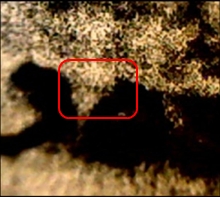Please click on this image to enlarge.....
After so many years you would think that the 'Code' found and associated with the Somerton Man would have been 'cracked' by now. But no, lots of attempts by hundreds if not thousands of people from around the world have not as yet managed to find a way to unravel these mysterious code letters.There can be no doubt that some very serious efforts have been made and this post is in no way meant to detract from all the extraordinarily hard work and effort put in by others. In fact without that I doubt whether what follows could have been discovered.
OK, so what's the deal you may well ask. It's simple, I posed a question some 18 months ago, what if the letters of the 'code' where not in fact the 'code'? What if somehow another level has lain hidden from view for close to 65 years?
That's the approach I took and the image below is part of the result of a detailed, up close examination of each letter that is found on the code page. This is just one of those letters:
This is in fact the letter 'C' the last letter in the fourth line of the code. All that happened here is that the letter was selected, viewed in some imaging editing software, GIMP for those interested, and a few very minor adjustments were made, brightness, contrast and curves. I have made an interesting discovery as to how you can take a fairly small letter, about 5 mm in height, and then effectively enlarge it without running the risk of distorting the image and that's something we will share in the coming weeks. Back to this image, what you can see in the highlighted area running from top to bottom is a name, the name of a person who was associated with the investigations into the discovery of the Somerton Man. It should be said up front that her name being found here does not imply that she had anything to do with this man's demise.
If I can draw your attention to that small serif at the base of the 'C', tucked inside it and at a slight angle you should be able to make out the shape of the letter 'N' the last letter in this persons name. Notice how the serif, which I think was in fact drawn by the Police at the time as they traced what they saw under a UV light, follows the line of the upstroke of the N and then down the down stroke.
What you are seeing here is Micro Writing, a little known but a well used technique by those in espionage and other clandestine occupations. Micro Writing has been recorded as being less than 1/10th mm in height and a record was set in the 1930's when a man, James W. Zaharee achieved the unbelievable feat of writing Lincoln's Gettysburg Address on a 3 inch long strand of human hair. In this image the micro letters are sub .3 mm in height
Call back soon because in the next post there will be more information on Micro Writing as well as more examples from the code page and other documents associated with this fascinating case.
Recently I shared some information on Micro Writing with friend and fellow Blogger Andrew May on his Forteana Blog, it's a great blog and Andrew has a nice, easy and informative style.






















